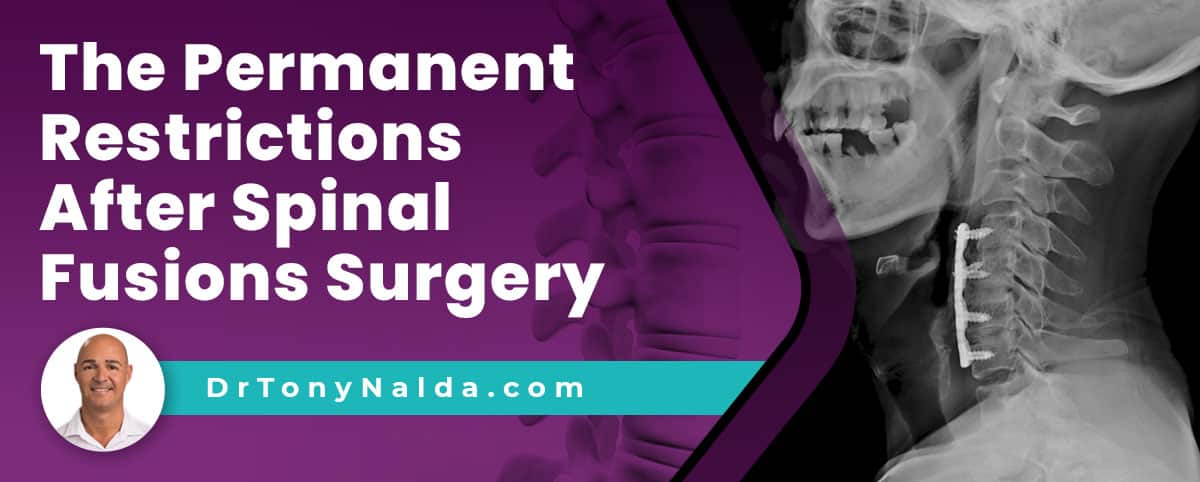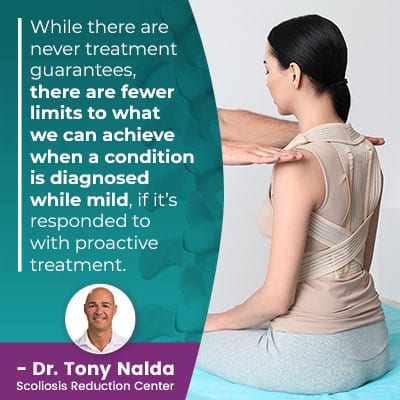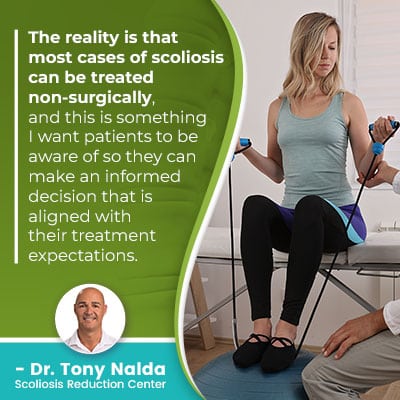The Permanent Restrictions After Spinal Fusions Surgery

While it’s impossible to predict the outcome of any surgical procedure with 100 percent accuracy, there are certain side effects and risks that are considered likely. When deciding whether or not to opt for surgery, patients have to weigh the risks carefully, as well as the benefits of alternative scoliosis treatment options.
Each person responds to spinal fusion surgery differently, based on key patient/condition variables such as age, condition severity, the number of vertebrae fused, and if there were complications. Common restrictions following spinal fusion can include a loss in spinal flexibility and range of motion.
Scoliosis is a complex condition with different treatment options, so let’s start our discussion of spinal fusion surgery restrictions by first exploring some key condition characteristics.
Understanding Scoliosis
Scoliosis is so often described as a complex condition to treat for a number of reasons.
First of all, scoliosis is highly variable, ranging in severity from mild to moderate and severe to very severe, and this is determined by a measurement known as the Cobb angle.
A patient’s Cobb angle tells me how far out of alignment a scoliotic spine is, and the higher the Cobb angle, the more severe the condition, and the more likely it is to cause noticeable symptoms like postural deviation and/or pain.
In addition, scoliosis is a 3-dimensional condition, and this is due to its rotational component.
A scoliotic spine doesn’t just bend unnaturally to the side but also twists from back to front, front to back, and if a treatment approach doesn’t address the condition’s true 3-dimensional nature, its efficacy is limited.
So for a person to be diagnosed with scoliosis, they have to have an unnatural sideways spinal curve, with rotation, and a minimum Cobb angle measurement of 10 degrees:
- Mild scoliosis: Cobb angle measurement of between 10 and 25 degrees
- Moderate scoliosis: Cobb angle measurement of between 25 and 40 degrees
- Severe scoliosis: Cobb angle measurement of 40+ degrees
- Very-severe scoliosis: Cobb angle measurement of 80+ degrees
One of the largest complexities of treating scoliosis is its progressive nature: scoliosis will get worse over time, particularly if left untreated.
So, where a scoliosis is at the time of diagnosis is not indicative of where it will stay. Mild scoliosis can easily progress to moderate, severe, and very severe; only proactive treatment can work towards counteracting the condition’s progressive nature.
In the context of spinal fusion surgery, progression is important because the end goal of spinal fusion is not to correct scoliosis but to stop it from progressing further, and this is an important distinction between traditional surgical scoliosis treatment and modern conservative scoliosis treatment.
Traditional Scoliosis Treatment
 Scoliosis is a structural spinal condition that’s been around since ancient times, and the traditional response to scoliosis treatment has been the dominant choice for many of those years.
Scoliosis is a structural spinal condition that’s been around since ancient times, and the traditional response to scoliosis treatment has been the dominant choice for many of those years.
Traditional scoliosis treatment has the end goal of stopping progression but doesn’t have a strategy for treating scoliosis while mild, which happens to be when it’s easiest to treat and the spine is most responsive to treatment.
As scoliosis progresses, the spine gets more rigid, and less responsive to treatment, and the body has more time to adjust to the unnatural curve’s presence.
While there are never treatment guarantees, there are fewer limits to what we can achieve when a condition is diagnosed while mild, if it’s responded to with proactive treatment.
A traditional response would tell a young patient with mild scoliosis to return for periodic assessments to see if their scoliosis is progressing, but as a progressive condition, we know it’s going to progress at some point, so I see this as wasting valuable treatment time.
While watching and waiting, a patient can experience growth spurts that trigger progression; growth and development is the condition’s main trigger for progression.
If a patient progresses into the severe classification at 40+ degrees and shows signs of continued progression, traditional treatment commonly recommends spinal fusion, which comes with its share of potential risks, complications, and side effects.
What is Spinal Fusion Surgery?
While there are different types of spinal fusion surgery, the procedure commonly involves fusing the most-tilted vertebrae (bones of the spine) of the curve into one solid bone.
Depending on the location of the fusion, this can involve the removal of the spine’s intervertebral discs, which perform many essential roles: providing cushioning between adjacent vertebrae, providing the spine with structure, enabling flexible movement, and acting as the spine’s shock absorbers.
Once the bones are fused together, rods are commonly attached to the spine with pedicle screws to hold it in place as it continues to fuse and heal, and the hardware used is permanently attached.
Now, each person will respond to the surgery in their own way, and this will be based on key patient/condition variables such as patient age and overall health, fusion location, the number of vertebrae fused, condition severity, and whether or not there were any complications during the surgery.
Immediately following the procedure, restrictions include lifting, bending, driving, and any strenuous twisting movements, and these will remain in place until the surgeon’s assessment has cleared the patient for regular activity.
In addition, there are certain risks associated with the procedure itself, and while all surgeries come with their share of risks, they are worthy of consideration:
- Nerve damage
- Excessive blood loss
- Infection
- Adverse reaction to hardware
Recovery time from the procedure itself will vary, and I want patients, and their families, to be aware of the long-term restrictions and effects of living with a fused spine, not all of which are known.
Permanent Restrictions After Spinal Fusion Surgery
Again, each patient will respond in their own way to spinal fusion, just as no two patients will experience life with scoliosis in the exact same way; the very nature of scoliosis necessitates the customization of effective treatment plans.
Following are some of the most common permanent restrictions and complaints that I’ve heard from patients who have undergone spinal fusion surgery:
- Pain at the fusion site
- Nerve damage
- Decreased spinal flexibility
- Decreased range of motion
- Disappointing cosmetic results
- A weaker spine that’s vulnerable to injury
- Hardware malfunction over time
As the spine is held in place artificially with rods and screws, it’s unable to move in the fused section, which, when successful, also eliminates the progression of the curve because the fused vertebrae can’t move and become more tilted.
However, this is contrary to the spine’s natural design and function, which is based on movement, and this doesn’t just affect the spine and its surrounding muscles.
As the muscles around the spine struggle to support the spine, they can become weak, strained, sore, and unbalanced.
 Spinal rigidity makes the spine stiff, weak, and sore, and as the muscles surrounding the spine also feel its effects, the increased pain at the fusion site and lack of spinal flexibility can result in a reduced range of motion, and this can cause activity restrictions.
Spinal rigidity makes the spine stiff, weak, and sore, and as the muscles surrounding the spine also feel its effects, the increased pain at the fusion site and lack of spinal flexibility can result in a reduced range of motion, and this can cause activity restrictions.
After undergoing spinal fusion surgery, individuals may face permanent restrictions, varying depending on the specific procedure such as microdiscectomy, laminectomy, or ACDF surgery. Additionally, limitations might also be imposed following SI joint fusion surgery, especially in cases of lumbar spinal stenosis or other lumbar spine surgeries, underscoring the importance of understanding the potential long-term impacts of spinal surgery.
The spine’s natural curves make it stronger, more flexible, and better able to absorb and distribute mechanical stress, so a spine that’s held in place artificially isn’t restoring its natural curves, making the spine less functional, strong, and more vulnerable to injury; this can also lead to certain activity restrictions.
In addition, the psychological effect of living with a spine that’s more vulnerable to an injury can be significant, making some people fearful of trying new things or taking part in once-loved activities and sports; this can impact their quality of life.
When it comes to disappointing cosmetic results, cosmetic reasons are the main motivation behind patients choosing spinal fusion surgery, but the reality is that as the surgery focuses solely on the spine, it doesn’t address related postural deviation, such as uneven shoulders and hips: something many patients regret not knowing beforehand.
One of the biggest concerns I have with spinal fusion surgery is the gap in the research/data on the long-term effects of living with a fused spine, and by long-term, I mean 20, 30, and 40+ years down the road. After all, the hardware used has to have natural longevity, so it is bound to fail at some point.
If hardware fails, such as a rod breaking, cracking, a screw coming loose, or an adverse reaction, the only recourse is more surgery, which only gets riskier with age, and the younger a patient is having the spinal fusion, the longer the hardware has to last.
Now, spinal surgeons obviously have their patients’ best interests at heart, and spinal fusion comes with risks, just as all surgical procedures do, and while it can be successful at straightening a bent spine, it can do so at the cost of overall spinal health and function.
The reality is that most cases of scoliosis can be treated non-surgically, and this is something I want patients to be aware of so they can make an informed decision that is aligned with their treatment expectations.
Conclusion
While there is no guarantee that patients will experience any of the aforementioned temporary, or permanent, restrictions after spinal fusion surgery, the risk is there so should be considered carefully.
What I want patients to understand is that there is more than one treatment option available, and while traditional scoliosis treatment funnels patients towards spinal fusion and doesn’t have a strategy for treating scoliosis while mild, modern conservative treatment values proactive treatment applied as close to the time of diagnosis as possible.
Here at the Scoliosis Reduction Center, I offer patients a non-surgical, conservative chiropractic-centered treatment approach driven by the end goal of correcting scoliosis, not just stopping it from getting worse.
Corrective results are worked towards by impacting the condition on a structural level through chiropractic care, adjusting the position of the most-tilted vertebrae back into alignment with the rest of the spine, in-office therapy to increase core strength for spinal support, corrective bracing to push the spine into a corrective position, and custom-prescribed exercises for establishing a home-rehabilitation program to further stabilize the spine.
Dr. Tony Nalda
DOCTOR OF CHIROPRACTIC
After receiving an undergraduate degree in psychology and his Doctorate of Chiropractic from Life University, Dr. Nalda settled in Celebration, Florida and proceeded to build one of Central Florida’s most successful chiropractic clinics.
His experience with patients suffering from scoliosis, and the confusion and frustration they faced, led him to seek a specialty in scoliosis care. In 2006 he completed his Intensive Care Certification from CLEAR Institute, a leading scoliosis educational and certification center.
About Dr. Tony Nalda
 Ready to explore scoliosis treatment? Contact Us Now
Ready to explore scoliosis treatment? Contact Us Now





